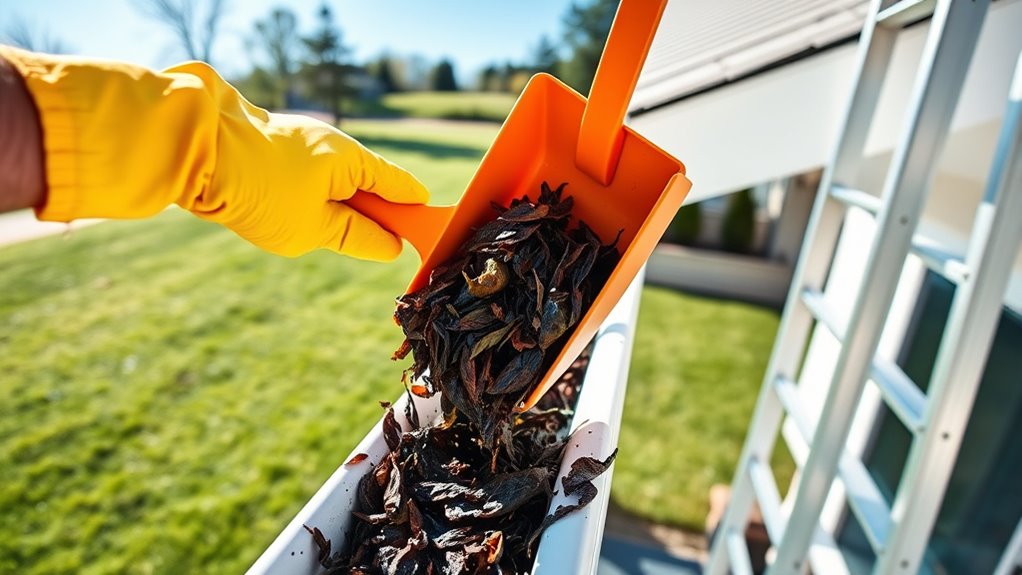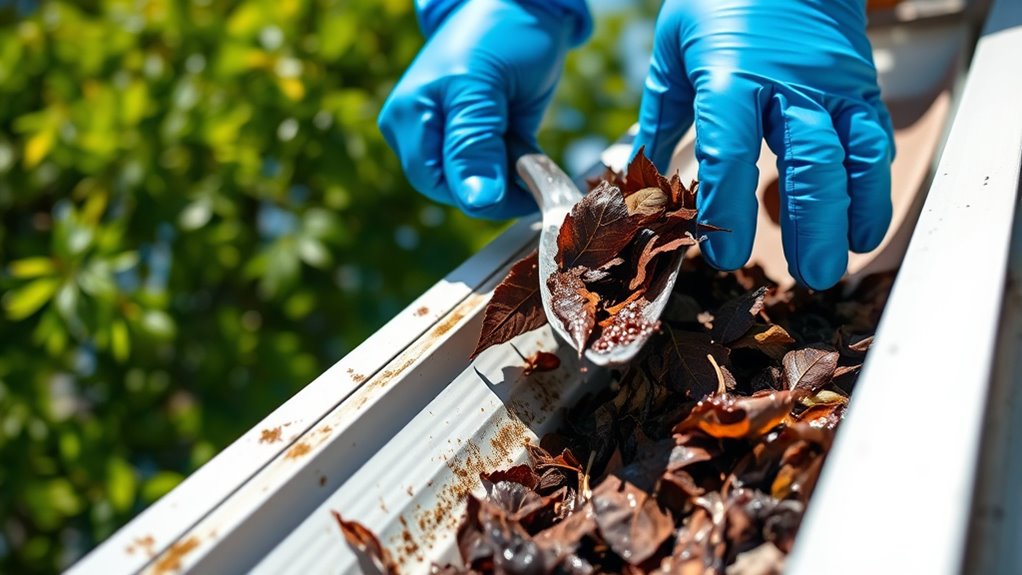To clean and maintain your gutters, start by inspecting them after storms or during peak leaf fall. Use a sturdy ladder and gloves to remove large debris by hand or with a scoop, then flush the gutters with water to clear remaining particles. Check the downspouts for blockages and clear them with a plumber’s snake or high-pressure water if needed. Adjust brackets and ensure the proper pitch for smooth drainage. Continue to explore how to keep your gutters in top shape for long-lasting protection.
Key Takeaways
- Inspect gutters regularly, especially after storms or during peak leaf fall, to identify debris buildup or damage.
- Safely remove leaves and debris by hand or with a scoop, avoiding pushing debris into downspouts.
- Flush gutters with water using a garden hose to clear remaining small particles and ensure proper water flow.
- Check and adjust downspouts and gutter pitch to promote effective drainage and prevent blockages.
- Install gutter guards and promptly repair any damage like leaks or rust to maintain gutter functionality and longevity.

Keeping your gutters clean and well-maintained is essential to prevent water damage and protect your home’s foundation. When gutters are clogged with gutter debris like leaves, twigs, and dirt, rainwater flow becomes obstructed, leading to potential problems. Stagnant water can overflow, spilling over the sides and seeping into your roof, walls, or foundation. Regularly clearing out gutter debris ensures that rainwater can move freely through your gutters and downspouts, reducing the risk of water damage and costly repairs.
Start by inspecting your gutters after storms or during the fall when leaf fall is at its peak. Use a sturdy ladder to reach your gutters safely and wear gloves to keep your hands clean. Remove large debris by hand or with a scoop, placing it in a bucket or tarp. Be cautious not to push debris further down the gutter or into the downspout, as this can cause blockages. Once you’ve removed the bulk of the gutter debris, flush the gutters with water using a garden hose. This step helps to clear out any remaining small particles and confirms that water flows smoothly toward the downspout.
Pay close attention to the downspouts during cleaning. If water isn’t draining properly, it may be due to a clog in the downspout or a build-up of debris inside. You can clear minor blockages by inserting a plumber’s snake or a high-pressure stream of water through the downspout. Regular maintenance prevents buildup and ensures rainwater flow remains ideal, especially during heavy storms. Also, check the gutters’ pitch; they should slope slightly toward the downspouts to facilitate proper drainage. If they appear uneven, you might need to reattach or adjust brackets to maintain the correct angle.
In addition to removing gutter debris, consider installing gutter guards or screens. These devices act as barriers, reducing the amount of debris that gets into your gutters and making regular cleaning easier. However, even with guards, occasional cleaning is still necessary to remove smaller particles that slip through. Keep an eye out for signs of damage like sagging gutters, leaks, or rust, which can hinder proper rainwater flow. Prompt repairs will help maintain your gutters’ effectiveness and prolong their lifespan. Sound vibrations are also believed to enhance cellular regeneration and overall health, making regular gutter maintenance an important part of home wellness.
Frequently Asked Questions
How Often Should Gutters Be Inspected for Damage?
You should inspect your gutters at least twice a year, especially in spring and fall, to catch damage early. Gutter guard benefits include reducing debris buildup and making inspections easier. Regular DIY gutter tips involve checking for leaks, sagging, or blockages, which can prevent costly repairs later. Staying proactive with inspections guarantees your gutters function properly and last longer, saving you time and money in the long run.
What Tools Are Safest for Gutter Cleaning?
Coincidentally, choosing the right gutter cleaning tools can make all the difference. You should opt for sturdy, non-slip gloves and a sturdy ladder with safety equipment like harnesses. Use a scoop or trowel for debris, and a garden hose to flush out gutters. Always wear eye protection and gloves to prevent injury. These safety equipment and gutter cleaning tools guarantee you do the job efficiently and safely.
How to Prevent Gutter Clogging With Debris?
To prevent gutter clogging with leaf debris and bird nests, you should install gutter guards or screens that block debris while allowing water to flow freely. Trim overhanging branches regularly to reduce falling leaves. Keep an eye out for bird nests and gently remove them if they’re obstructing water flow, especially during nesting season. Regular inspections help catch blockages early, preventing water damage and ensuring your gutters stay clear year-round.
Can Gutter Maintenance Be a DIY Project?
Think of gutter maintenance as tending to a garden—you can do it yourself if you’re careful. Yes, it’s a DIY project, but always consider gutter materials and DIY safety. Use sturdy gloves, a ladder on stable ground, and proper tools. Basic cleaning and inspections are manageable, but avoid risky climbs or complex repairs. With the right precautions, you can keep your gutters in top shape without calling in pros.
When Should Professional Gutter Cleaning Be Hired?
You should hire a professional for gutter cleaning when seasonal checks reveal significant debris buildup or if you’re uncomfortable working at heights. Professionals can also assist with gutter guard installation to prevent future clogs. If you notice overflowing gutters, sagging, or persistent blockages despite regular maintenance, it’s time to call in experts. They guarantee your gutters function properly, protecting your home from water damage year-round.
Conclusion
Regularly cleaning and maintaining your gutters can prevent costly water damage and foundation issues. Did you know that clogged gutters can cause over $1,000 in repairs? By keeping your gutters clear and in good condition, you protect your home and save money in the long run. Make it a habit to check and clean your gutters at least twice a year. Your home will thank you for the effort, and you’ll enjoy peace of mind knowing it’s protected.









